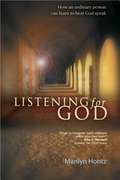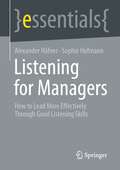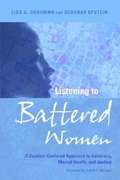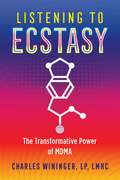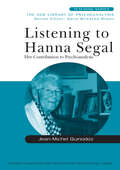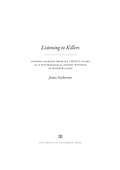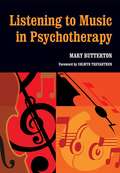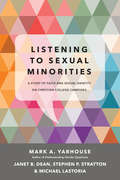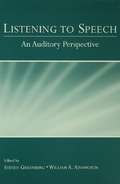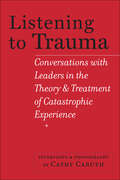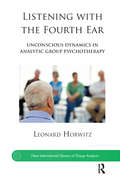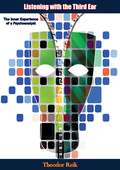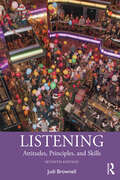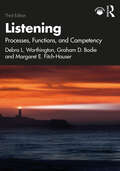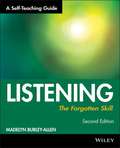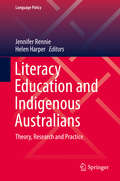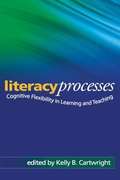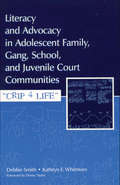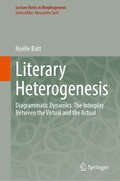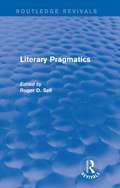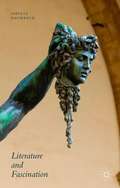- Table View
- List View
Listening for God: How an Ordinary Person Can Learn to Hear God Speak
by Marilyn HontzThrough personal stories and scriptural principles, author Marilyn Hontz brings new insight to the practice of listening as a spiritual discipline. She discusses "Recognizing God's Voice While Reading Scripture," "Recognizing God's Voice While Praying," and "Recognizing God's Voice While Listening" and provides practical suggestions for cultivating a two-way conversation with God.
Listening for Managers: How to Lead More Effectively Through Good Listening Skills (essentials)
by Alexander Häfner Sophie HofmannManagers who listen well thus create trusting relationships with their employees. They promote job satisfaction, employee loyalty and performance. Good listening reduces the risk of burnout. The book provides tips for managers to improve their listening skills and thus lead more effectively.Unfortunately, self-perception and the image of others often diverge greatly: those who believe themselves to be good listeners are often perceived quite differently by others. This makes critical self-reflection, external feedback and practice all the more important. The book provides a variety of suggestions for this.
Listening to Battered Women: A Survivor-Centered Approach to Advocacy, Mental Health, and Justice
by Deborah Epstein Lisa A. GoodmanListening to Battered Women: A Survivor-Centered Approach to Advocacy, Mental Health, and Justice presents an in-depth, multidisciplinary look at society's responses to domestic violence. Though substantial reforms have been made in the services available to battered women since the 1970s, the book shows how the public and private systems available to victims of domestic violence are still failing to meet the needs of the women who seek help. Using a feminist perspective, authors Lisa Goodman and Deborah Epstein explore and critique the current available services in three different arenas: the domestic violence advocacy community, the mental health profession, and the justice system. In recent years, the options available to battered women have expanded dramatically. However, these reforms have been made at the expense of the contextualized, women-centered focus that was once at the heart of the anti-domestic violence movement. The authors argue that a renewed focus on the principles of the early feminist movement - for example, listening to individual women's voices, promoting supportive communities, and facilitating economic empowerment, could result in substantial progress in efforts to protect and counsel battered women. A series of concrete recommendations for improvements in the advocacy, mental health, and justice systems are also discussed. Researchers interested in the field of violence, gender studies, psychology of women, mental health trauma, or family law, as well as practitioners working with the victims of intimate partner violence, will find this book to be a valuable resource in their efforts.
Listening to Ecstasy: The Transformative Power of MDMA
by Charles WiningerA personal narrative and guide to the safe, responsible use of MDMA for personal healing and social transformation • Details the author&’s 50 years of responsible experimentation with mind-altering substances and how Ecstasy has helped him become a better therapist • Explains how he and his wife found Ecstasy to be the key to renewing and enriching their lives and marriage as they entered their senior years • Describes what the experience actually feels like and provides protocols for the safe, responsible, recreational, and celebrational use of MDMA for individuals and groups In a world that keeps us separate from each other, MDMA is the chemical of connection. Aptly known in popular culture as &“Ecstasy,&” MDMA helps us rediscover our own true loving nature, often obscured by the traumas of life. On its way to becoming a prescription medication due to groundbreaking research on its use to treat PTSD, Ecstasy can offer benefits for all adult life stages, from 20-somethings to seniors. In this memoir and guide to safe use, Charles Wininger, a licensed psychoanalyst and mental health counselor, details the countless ways that Ecstasy has helped him become a better therapist and husband. He recounts his coming of age in the 1960s counterculture, his 50 years of responsible experimentation with mind-altering substances, and his immersion in the new psychedelic renaissance. He explains how he and his wife found Ecstasy to be the key to renewing and enriching their lives as they entered their senior years. It also strengthened the bonds of their marriage. Countering the fearful propaganda that surrounds this drug, Wininger describes what the experience actually feels like and explores the value of Ecstasy and similar substances for helping psychologically healthy individuals live a more &“optimal&” life. He provides protocols for the responsible, recreational, and celebrational use of MDMA, including how to perfect the experience, maximize the benefits and minimize the risks, and how it may not be for everyone. He reveals how MDMA has revitalized his marriage, both erotically and emotionally, and describes how pleasure, fun, and joy can be profound bonding and transformative experiences. Revealing MDMA&’s versatility when it comes to bringing lasting renewal, pleasure, and inspiration to one&’s life, Wininger shows that recognizing the transformative power of happiness-inducing experiences can be the first step on the path to healing.
Listening to Hanna Segal: Her Contribution to Psychoanalysis (New Library of Psychoanalysis Teaching Series)
by Jean-Michel QuinodozWinner of the 2010 Sigourney Award! How has Hanna Segal influenced psychoanalysis today? Jean-Michel Quinodoz provides the reader with a comprehensive overview of Segal's life, her clinical and theoretical work, and her contribution to psychoanalysis over the past sixty years by combining actual biographical and conceptual interviews with Hanna Segal herself or with colleagues who have listened to Segal in various contexts. Listening to Hanna Segal explores both Segal's personal and professional histories, and the interaction between the two. The book opens with an autobiographical account of Segal's life, from her birth in Poland to her analysis with Melanie Klein in London where she became the youngest member of the British Psychoanalytical Society. Quinodoz goes on to explain Segal's contributions in various fields of psychoanalysis including: the psychoanalytic treatment of psychotic patients the introduction of the "symbolic equation" aesthetics and the creative impulse the analysis of elderly patients introducing the work of Melanie Klein. Quinodoz concludes by examining Segal's most recent contribution to psychoanalysis - exploring nuclear terror, psychotic anxieties, and group phenomena. Throughout the interviews Segal speaks of her close relationships with prominent colleagues such as Klein, Rosenfeld, and Bion, making this book both a valuable contribution to the history of psychoanalysis and an indication of the evolution of psychoanalytic ideas over the past six decades. This clear summary of Hanna Segal's life and her contribution to psychoanalysis will be an essential guide to anyone studying Segal and her contemporaries.
Listening to Killers
by James GarbarinoListening to Killers offers an inside look at twenty years' worth of murder files from Dr. James Garbarino, a leading expert psychological witness who listens to killers so that he can testify in court. The author offers detailed accounts of how killers travel a path that leads from childhood innocence to lethal violence in adolescence or adulthood. He places the emotional and moral damage of each individual killer within a larger scientific framework of social, psychological, anthropological, and biological research on human development. By linking individual cases to broad social and cultural issues and illustrating the social toxicity and unresolved trauma that drive some people to kill, Dr. Garbarino highlights the humanity we share with killers and the role of understanding and empathy in breaking the cycle of violence.
Listening to Music in Psychotherapy (Radcliffe Ser.)
by Mary ButtertonEvidence-based change is central to many recent developments in the NHS. This book brings together practical and personal experiences from a wide range of externally evaluated healthcare projects. It demonstrates how to facilitate and promote evidence-based change by drawing on realistic advice on what is, and is not, effective. It enables readers to benefit from lessons learned and provides a comprehensive insight into implementing changes based on research evidence, across broad range of settings in the NHS. 'An important book. It has many exciting insights, enjoy it.' Jenny Simpson in the Foreword 'A unique collection. There are some brave admissions and this is probably the best attempt yet to capture the nitty-gritty of the evidence-into-practice agenda in UK healthcare. I hope you find it a gripping read'. Trisha Greenhalgh in the Foreword
Listening to Prozac: The Landmark Book About Antidepressants and the Remaking of the Self
by Peter D. KramerThe New York Times bestselling examination of the revolutionary antidepressant, with a new introduction and afterword reflecting on Prozac&’s legacy and the latest medical research &“Peter Kramer is an analyst of exceptional sensitivity and insight. To read his prose on virtually any subject is to be provoked, enthralled, illuminated.&” —Joyce Carol Oates When antidepressants like Prozac first became available, Peter D. Kramer prescribed them, only to hear patients say that on medication, they felt different—less ill at ease, more like the person they had always imagined themselves to be. Referencing disciplines from cellular biology to animal ethology, Dr. Kramer worked to explain these reports. The result was Listening to Prozac, a revolutionary book that offered new perspectives on antidepressants, mood disorders, and our understanding of the self—and that became an instant national and international bestseller. In this thirtieth anniversary edition, Dr. Kramer looks back at the influence of his groundbreaking book, traces progress in the relevant sciences, follows trends in the use and public understanding of antidepressants, and assesses potential breakthroughs in the treatment of depression. The new introduction and afterword reinforce and reinvigorate a book that the New York Times called &“originally insightful&” and &“intelligent and informative,&” a window on a medicine that is &“telling us new things about the chemistry of human character.&”
Listening to Sexual Minorities: A Study of Faith and Sexual Identity on Christian College Campuses (Christian Association for Psychological Studies Books)
by Mark A. Yarhouse Janet B. Dean Stephen P. Stratton Michael LastoriaListening to Sexual Minorities
Listening to Speech: An Auditory Perspective
by Steven Greenberg William A. AinsworthThe human species is largely defined by its use of spoken language, so integral is speech communication to behavior and social interaction. Despite its importance in everyday life, comparatively little is known about the auditory mechanisms that underlie the ability to understand language. The current volume examines the perception and processing of speech from the perspective of the hearing system. The chapters in this book describe a comprehensive set of approaches to the scientific study of speech and hearing, ranging from anatomy and physiology, to psychophysics and perception, and computational modeling. The auditory basis of speech is examined within a biological and an evolutionary context, and its relevance to applied domains such as communication disorders and speech technology discussed in detail. This volume will be of interest to scientists, engineers, and clinicians whose professional work pertains to any aspect of spoken language or hearing science.
Listening to Trauma: Conversations with Leaders in the Theory and Treatment of Catastrophic Experience
by Cathy CaruthInterviews and intimate photographic portraits of witnesses to the collective and cultural significance of trauma.This new collection from Cathy Caruth features interviews with a diverse group of leaders in the theorization of, and response to, traumatic experience in the twentieth and twenty-first centuries. Crossing the boundaries of discipline and profession, Caruth’s subjects include literary theorists and critics, psychoanalysts, psychiatrists, psychologists, political activists, filmmakers, public intellectuals, institutional leaders, and researchers. Exploring the intertwining of the intellectual and personal dimensions of experience, each interview is accompanied by Caruth's intimate photographic portrait of its subject. Caruth chose her subjects because of their impact on her thinking as well as their significant role as witnesses to the collective and cultural significance of trauma. The individuals profiled here are innovators in the theory of trauma (Part I), in the clinical, activist, or testimonial interventions in trauma (Part II), or in the creation or modification of institutions that provide therapeutic, artistic, or legal responses to traumatic events (Part III). Two of the interviews first appeared in Caruth's landmark 1995 work, Trauma: Explorations in Memory. The rest were conducted between 2011 and 2013 after the field of trauma studies expanded significantly. Representing both the foundation of trauma research and cutting-edge approaches to the topic, this collection will be useful to practitioners with an interest in post-traumatic stress disorder as well as scholars exploring the multiple dimensions of profound human experience.A portion of the proceeds from sales of this book will go to the Grady Nia Project for abused, suicidal, and low-income African American women.
Listening to Women After Childbirth
by Emma Williamson Alison BrodrickIt is vital that healthcare practitioners understand the psychological impact of childbirth when caring for women. This accessible guide is designed to improve the care that women receive and, as a result, public health outcomes related to maternal and infant wellbeing. This book outlines how clinicians can offer practical support to women after birth. It: discusses what we know about how women adapt to motherhood and develop a post-childbirth identity; outlines some of the causes and manifestations of post-traumatic stress following childbirth; provides practical guidance for setting up postnatal pathways for women traumatised by birth and how to communicate effectively; equips practitioners with the knowledge and skills to support pregnant women with a fear of birth; incorporates narratives from women to demonstrate how their births and related events were perceived and processed, before discussing how women’s views can be used to inform future practice; highlights the importance of restorative supervision for healthcare professionals working in this area to promote staff resilience and sustainability. Drawing together theoretical knowledge, evidence, practical skills and women’s narratives to help clinicians understand the psychology of childbirth and support women, it is of significant value to all healthcare practitioners engaged in maternity services.
Listening with the Fourth Ear: Unconscious Dynamics in Analytic Group Psychotherapy (The New International Library of Group Analysis)
by Leonard HorwitzThere are multiple meanings to the term 'group-as-a-whole' and all have a contribution. This book emphasizes that the therapist ideally listens with the fourth ear, not only attending to the latent communication of each individual, but also listening for the shared theme of the whole group. Ferreting out the underlying theme that the entire group is dealing with, the common group tension, provides a valuable opportunity for each individual to change the underlying issues that impair his or her relationships. In addition, the author provides a wide ranging coverage of theoretical, clinical, and training issues. These include a clarification of the confusing, but all-important conception of projective identification as well as a contribution to the understanding of the similarities and differences between group and individual psychotherapy. He presents a special perspective on why groups are particularly indicated in dealing with narcissistic pathology and also explores the effect of the therapist's narcissism on his patients. Finally, he emphasizes that therapists' participation as members of experiential groups is an essential part of their training.
Listening with the Third Ear: The Inner Experience of a Psychoanalyst
by Theodor ReikA discourse on non-verbal communication. Austrian-born psychoanalyst Theodor Reik (1888 - 1969), one of Freud's first students, and pioneer of lay analysis in the U.S., examines how subtle nuances of interpersonal communication are expressed & perceived at unconscious levels which can only be decipherable by analysts looking inwards and listening with the third ear (term borrowed from Nietzsche). This volume contains numerous clinical examples detailing subtle, influential clues expressed in the patient’s patterns of behaviors such as dress, peculiarities in gestures, flickering of eyes, and even the warmth, clamminess, roughness or smoothness of the skin conveyed in shaking of the hand ---- all to which we respond to unconsciously yet influences our opinions. Since minute movements speak as powerfully as words, one needs to turn attention inward.…46 chapters in 4 parts: Part I, "I am a Stranger Here Myself"; II, The Workshop; III, Two-Way Street; and IV, The Language of the Soul, followed by "Leave-Taking".-Print ed.
Listening: Attitudes, Principles, and Skills
by Judi BrownellThis fully updated seventh edition takes an experiential approach to listening instruction, providing extensive applied examples and cases within the context of the HURIER listening model. This textbook encourages students to view listening as a process involving six interrelated components which are developed along the parallel dimensions of theory and skill building. This new edition includes additional and updated cases, exercises, and questions for discussion to address students’ world of evolving technology, expanding social boundaries, and global communication challenges. A new challenge, integrative listening, addresses students’ social responsibility as effective listeners and suggests that they apply their skills to create strong listening environments characterized by respectful and inclusive dialogue. Students move from self-reflection and self-knowledge through skill development and personal applications to creating listening environments that facilitate productive conversation and collaboration. Cases in “the bigger picture” address issues such as the opioid crisis, fake news, artificial intelligence, and teenagers’ mental health. Listening serves as a core textbook for courses in listening, communication studies, communication skills, interpersonal communication, management, human resources, and education.
Listening: Attitudes, Principles, and Skills
by Judi BrownellProvides an applied, experiential approach to listening instruction with special attention to interpersonal, family, professional, educational, and health contexts Market leading text for Listening courses in Communication, with additional application for management, education, and human resources courses Text contains practical features including case studies, exercises, discussion questions, and journal assignments --Online resources include PowerPoint slides and exercises
Listening: Processes, Functions, and Competency
by Debra L. Worthington Margaret E. Fitch-Hauser Graham D. BodieThis fully revised third edition explores the essential role of listening to human communication across contexts and cultures.Based on the premise that listening is a goal-directed activity, this book blends theory with practical application and builds knowledge, insight, and skills to help the reader become a more effective listener. In this new edition, theory and research has been updated with an emphasis on how the growing reliance on mediated communication affects how individuals communicate in their personal, professional, and educational lives. It introduces students to emerging concepts and methods such as neurodiversity and fMRI as well as evolving professional and educational contexts including aural architecture and "the musical brain".Addressing listening as a cognitive process, social function, and critical professional competency, this is an essential textbook for undergraduate courses in listening and communication studies.In addition to a fully updated instructor’s manual containing discussion questions, activities and assignments, and exam questions, this new edition includes PowerPoint slides and videos. They are available at http://www.routledge.com/9781032491257.
Listening: The Forgotten Skill (A Self-Teaching Guide), Second Edition
by Madelyn Burley-AllenA proven program for turning effective listening into a powerful business tool Managers and other employees spend more than 40 percent of their time listening to other people but often do it so poorly that the result is misunderstood instructions, misdirected projects, and erroneous actions--millions of dollars' worth of mistakes just because most people don't know how to listen. In this new edition of her classic guide to the art of effective listening, Madelyn Burley-Allen shows you how to acquire active, productive listening skills and put them to work for you--professionally, socially, and personally. With her time-tested techniques, you'll learn how to:<p><p> * Eliminate distractions and improve your concentration on what is being said<br> * Locate key words, phrases, and ideas while listening<br> * Cut through your own listening biases<br> * Interpret body language clues<br> * Ask constructive, nonthreatening questions that elicit real information<br> * Get others to listen to you<br> * Master a whole range of listening skills that you can use on the job and in your personal life<p> Listening: The Forgotten Skill uses an interactive learning approach with work-sheets, charts, graphs, and self-tests that help you pace and monitor your own progress.
Literacy Education and Indigenous Australians: Theory, Research and Practice (Language Policy #19)
by Jennifer Rennie Helen HarperThis edited volume brings together diverse perspectives on Australian literacy education for Indigenous peoples, highlighting numerous educational approaches, ideologies and aspirations. The Australian Indigenous context presents unique challenges for educators working across the continent in settings ranging from urban to remote, and with various social and language groups. Accordingly, one of the book’s main goals is to foster dialogue between researchers and practitioners working in these contexts, and who have vastly different theoretical and ideological perspectives. It offers a valuable resource for academics and teachers of Indigenous students who are interested in literacy-focused research, and complements scholarship on literacy education in comparable Indigenous settings internationally.
Literacy Processes
by Gedeon O. Deak Kelly B. CartwrightReading and writing instruction require individuals--both students and teachers--to flexibly process many kinds of information, from a variety of sources. This is the first book to provide an in-depth examination of cognitive flexibility: how it develops across the lifespan; its role in specific literacy processes, such as phonemic awareness, word recognition, and comprehension; and implications for improving literacy instruction and teacher education. The contributors include leading researchers in literacy, psychology, and cognitive development, who summarize the current state of the science and offer practical suggestions for fostering cognitive flexibility in learners of all ages.
Literacy and Advocacy in Adolescent Family, Gang, School, and Juvenile Court Communities: Crip 4 Life
by Kathryn F. Whitmore Debra SmithThe goal of this book is to encourage educators and researchers to understand the complexities of adolescent gang members' lives in order to rethink their assumptions about these students in school. The particular objective is to situate four gang members as literate, caring students from loving families whose identities and literacy keep them on the margins of school. The research described in this book suggests that advocacy is a particularly effective form of critical ethnography. Smith and Whitmore argue that until schools, as communities of practice, enable children and adolescents to retain identities from the communities in which they are full community members, frightening numbers of students are destined to fail.The stories of four Mexican American male adolescents, who were active members of a gang and Smith's students in an alternative high school program, portray the complicated, multiple worlds in which these boys live. As sons and teenage parents they live in a family community; as CRIP members they live in a gang community; as "at risk" students, drop-outs, and graduates they live in a school community, and as a result of their illegal activities they live in the juvenile court community. The authors theorize about the boys' literacy in each of their communities. Literacy is viewed as ideological, related to power, and embedded in a sociocultural context. Vivid examples of conversation, art, tagging, rap, poetry, and other language and literacy events bring the narratives to life in figures and photographs in all the chapters. Readers will find this book engaging and readable, yet thought provoking and challenging.Audiences for Literacy and Advocacy in Adolescent Family, Gang, School, and Juvenile Court Communities include education researchers, professionals, and students in the areas of middle/high school education, at-risk adolescent psychology, and alternative community programs--specifically those interested in literacy education, sociocultural theory, and popular culture.
Literacy in the Early Grades: A Successful Start For PreK-4 Readers and Writers
by Gail Tompkins Emily RodgersA practical and balanced approach to helping young students become fluent readers and writers Literacy in the Early Grades: A Successful Start for PreK-4 Readers and Writers presents a balanced approach to literacy instruction that will help all young students make a successful start in reading and writing. <p><p>Effective teachers know their students’ individual needs, and use their understanding of literacy development to guide their teaching. The 5th Edition provides the background knowledge, modeling, and practical resources – including authentic classroom vignettes, student work samples, minilessons, assessment tools, and a Compendium of Instructional Procedures – that will ensure you are well prepared to meet grade-level standards and lead young students to become fluent readers and writers.
Literary Heterogenesis: Diagrammatic Dynamics. The Interplay Between the Virtual and the Actual (Lecture Notes in Morphogenesis)
by Noëlle BattThis book advances a new interdisciplinary approach that engages with the concepts of science and literature through the mediation of philosophy (with a focus on the ideas of Gilbert Simondon and Gilles Deleuze). It investigates in innovative ways the multifaceted dimensions of creation, of genesis, considered here in artistic and mathematical terms as “heterogenesis”. The dialogic interaction among the three domains generates a renewed analysis of poems selected in the work of particularly inventive poets, both French and American—Emily Dickinson, e.e. cummings and Francis Ponge—as well as the artwork of Pierre Soulages, Anna-Eva Bergman and Cy Twombly. Literary Heterogenesis. Diagrammatic Dynamics. The Interplay of the Virtual and the Actual will interest specialists of mathematics, physics, literary theory and criticism, philosophy, and epistemology. It will also attract any curious mind drawn to the bridging of disciplines and the concepts of the two cultures.
Literary Pragmatics: Criticism, Theory, Education. Selected Papers 1985-2002 (Routledge Revivals #10)
by Roger D. SellUp until the mid-1980s most pragmatic analysis had been done on spoken language use, considerably less on written use, and very little at all on literary activity. This has now radically changed. ‘Pragmatics’ could be informally defined as the study of relationships between language and its users. This volume, first published in 1991, seeks to reposition literary activity at the centre of that study. The internationally renowned contributors draw together two main streams. On the one hand, there are concerns which are close to the syntax and semantics of mainstream linguistics, and on the other, there are concerns ranging towards anthropological linguistics, socio- and psycholinguistics. Literary Pragmatics represents an antidote to the fragmenting specialization so characteristic of the humanities in the twentieth century. This book will be of lasting value to students of linguistics, literature and society. Roger D. Sell discusses the reissue of Literary Pragmatics here: http://www.routledge.com/articles/roger_d._sell_discusses_the_reissue_of_literary_pragmatics/
Literature and Fascination
by Sibylle BaumbachThis book explores literary fascination. Why do some texts capture us more than others; how do concepts of fascination evolve; what part does literature play in this; and how can literary fascination be pinpointed and conceptualised? Offering detailed case studies that include texts by William Shakespeare, S.T. Coleridge, Mary Shelley, Bram Stoker, Oscar Wilde, Joseph Conrad, Don DeLillo, and Ian McEwan, this study investigates various mechanisms of fascination across different verbal media of attraction. It illuminates the ways in which these texts are designed, presented, and received and develops fascination as a key concept of aesthetic attraction that provides insight into our understanding of how perception functions with regard to literature and how it has evolved. Synthesizing these analyses, the book argues that narratives of fascination essentially work with medusamorphosis, a concept that takes its cue from the Gorgon Medusa and aids the analysis of key mechanisms used to elicit fascination.
